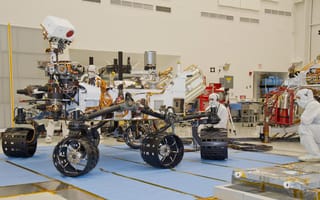When a company decides to come out of stealth mode, it usually means they have an amazing piece of technology to show off. So when we hear of a Seattle startup revealing its mission and plan to achieve it to the wider world, we sit up and take notice. A handful of particularly impressive startups have stepped out of the shadows already in 2019, so we decided to shine a light on who they are, what they’re working on and why.

What were they hiding? A design, engineering and complex system development service that uses the “tools of deep space exploration” to tackle industrial challenges “on and off the planet.”
Details: Originally founded as Synchronous early last year, First Mode boasts an impressive lineup of scientists, engineers and strategists with experience from Spaceflight Industries, Boeing, Intel, asteroid mining startup Planetary Resources and NASA’s Mars Exploration and Rover programs. Leveraging this impressive team, the company says it can solve complex problems in everything from space exploration and robotics to data science and agriculture. The company claims to have successfully completed at least 40 projects with 10 different organizations, including missions in space, creating consumer product prototypes and electrifying industrial platforms.
A lot of what makes programs like Apollo or (the) Mars Rovers so impressive isn’t the individual pieces of technology, but the coordination of hundreds of thousands of parts, people, companies and priorities.”
Quotable quote: “The team at First Mode has always been fascinated with the types of problems that seem too big or too complex for any one group to tackle,” President and Chief Engineer Chris Voorhees said in a statement. “A lot of what makes programs like Apollo or (NASA’s Jet Propulsion Labs’) Mars Rovers so impressive isn’t the individual pieces of technology, but the coordination of hundreds of thousands of parts, people, companies and priorities. The methods used for solving these types of problems are just as relevant to applications here on Earth, where the combination of safety criticality, required function, constraint, and environment can create what initially appears to be an intractable problem. We help our clients methodically break it down into a set of smaller, connected developments that can be put together to realize the larger whole.”

Founded: 2012
What were they hiding? AI technology that sifts through huge and diverse datasets to create new products and services for enterprise clients.
Details: While it wasn’t necessarily trying to hide its technology, Koverse president and CEO Jon Matsuo said clients usually ask the company to keep quiet the work they do. However, Koverse got a rare opportunity to strut its stuff in January, unveiling a big data platform designed to help audit giant PwC assess global supply chains for risk. The technology, called “Know Your Vendor,” identifies anything from minor oversights to major human rights abuses. Koverse co-founders Aaron Cordova and Paul Brown originally worked together at the National Security Agency, where they built that organization’s first big data platform, and have incorporated that technology into Koverse’s services.
We’re generally helping these organizations with something that’s fundamentally ingrained in their service.”
Quotable quote: “Our customers don’t want us talking about what we’re doing with them, and so they put the clamps on us,” Matsuo said in an interview with Built In Seattle. “We’re really helping them with strategic use cases; it’s not operational stuff where you’re saving 10 percent here or there. We’re generally helping these organizations with something that’s fundamentally ingrained in their service — a new product or service, or something that really gives them a competitive edge.”

What were they hiding? A cybersecurity product suite that protects endpoints, perimeter firewalls that can perform automatic troubleshooting, “self-healing” recovery and more.
Details: Cyemptive did its big reveal last month, pulling the curtain on its technology, team and a $3.5 million Series A round of financing — though it declined to reveal the identity of its investors. The company’s leadership features cybersecurity experts from Hitcachi, Microsoft, Hewlett Packard and the NSA. If that wasn’t impressive enough, the company also revealed that it had beaten out 89 competitors to win a competition held by the Department of Homeland Security’s Border Security Technology Consortium, where security-minded startups pitched services and products with a panel of cyber experts.
We’re approaching the problem from a completely different perspective than others in the market.”
Quotable quote: “Emerging threats tied to cybersecurity stand to affect business and government operations dramatically in the near future,” Founder and CEO Rob Pike said in a statement. “We’re approaching the problem from a completely different perspective than others in the market, with a focus on ensuring networks and files remain in a good known state at all times. Instead of relying solely on looking for known threats or leveraging machine learning to try to find unwanted activity, we disallow actions that would corrupt a system or encrypt a file in the first place.”

What were they hiding?: A light field capture and rendering system which allows doctors to view and navigate real-time 3D video projections of a living person’s anatomy.
Details: Proprio Vision’s proprietary technology uses networked camera arrays, depth-sensing technology and computer graphics processing to produce a virtual representation of the human body — say, the circulatory or skeletal system — for use by physicians. The goal is to replace microscopes, loupes, screens and other traditional surgery visualization tools with technology that leverages augmented and virtual reality, machine learning and computer vision. As it revealed its technology, the company also announced that it had raised $7 million in funding. CEO Gabriel Jones previously evaluated emerging technologies for the Bill and Melinda Gates Foundation, while Chief Medical Officer Samuel Browd is a pediatric neurosurgeon at Seattle Children’s Hospital, as well as a professor of neurological surgery at UW who has worked with a number of startups throughout his career — a notable example of which is football helmet designer VICIS.
It’s hard to wrap your head around. But it means that where you are, or were, when something was captured no longer matters.”
Quotable quote: “Light field gives us immersive, more accurate, much richer data about the world around us than any other system could,” Jones told Geekwire. “It’s hard to wrap your head around. But it means that where you are, or were, when something was captured no longer matters.”







